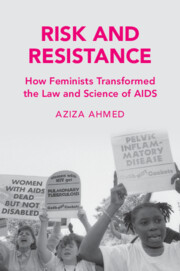Refine search
Actions for selected content:
347 results
4 - Labor, Gender, and Civil Society Mobilization
- from Part II - Politics from Below
-
- Book:
- Democracy and Inequality in India
- Published online:
- 11 October 2025
- Print publication:
- 30 October 2025, pp 136-198
-
- Chapter
- Export citation

Pious Politics
- Cultural Foundations of the Islamist Movement in Turkey
-
- Published online:
- 21 October 2025
- Print publication:
- 30 October 2025
Adoption and Implementation as a Two-Stage Process: Feminist Strategies and Conservative Resistance in the Quest for Legislative Abortion Reform
-
- Journal:
- Perspectives on Politics , First View
- Published online by Cambridge University Press:
- 20 October 2025, pp. 1-21
-
- Article
-
- You have access
- Open access
- HTML
- Export citation
Conclusion
-
- Book:
- Risk and Resistance
- Published online:
- 10 September 2025
- Print publication:
- 09 October 2025, pp 145-151
-
- Chapter
- Export citation
3 - Structural Inequality and the Evolving Movements for Land-Use Justice
-
-
- Book:
- Racial Justice in American Land Use
- Published online:
- 19 September 2025
- Print publication:
- 09 October 2025, pp 69-98
-
- Chapter
- Export citation
“Revolution” as Restoration: Woman, Life, Freedom in the Diasporic Imaginary
-
- Journal:
- Iranian Studies ,
- Published online by Cambridge University Press:
- 07 October 2025, pp. 1-7
-
- Article
-
- You have access
- Open access
- HTML
- Export citation
4 - Re-presenting Rights
-
-
- Book:
- Reckoning with Law in Excess
- Published online:
- 09 September 2025
- Print publication:
- 25 September 2025, pp 96-119
-
- Chapter
-
- You have access
- Open access
- HTML
- Export citation
8 - Plurinational Juristocracy and Rights from Below at Bolivia’s Gas Frontier
-
-
- Book:
- Reckoning with Law in Excess
- Published online:
- 09 September 2025
- Print publication:
- 25 September 2025, pp 186-211
-
- Chapter
-
- You have access
- Open access
- HTML
- Export citation
Women, Feminism, and the Construction of Collective Memory: Community-Based Memory Projects in Postconflict Colombia: The Case of Medellín
-
- Journal:
- Latin American Research Review ,
- Published online by Cambridge University Press:
- 22 September 2025, pp. 1-23
-
- Article
-
- You have access
- Open access
- HTML
- Export citation

Risk and Resistance
- How Feminists Transformed the Law and Science of AIDS
-
- Published online:
- 10 September 2025
- Print publication:
- 09 October 2025

From Manners to Rules
- Advocating for Legalism in South Korea and Japan
-
- Published online:
- 29 August 2025
- Print publication:
- 07 August 2025
Running Fast, Just to Stay in the Same Place? Social Movements, Political Parties, and the Politics of the Portuguese Informal Caregiver Statute (2015–2019)
-
- Journal:
- Social Policy and Society , First View
- Published online by Cambridge University Press:
- 26 August 2025, pp. 1-16
-
- Article
-
- You have access
- Open access
- HTML
- Export citation
Parliamentary Activism? Northern Irish Civil Rights and the Campaign for Democracy in Ulster
-
- Journal:
- Transactions of the Royal Historical Society , First View
- Published online by Cambridge University Press:
- 12 August 2025, pp. 1-23
-
- Article
-
- You have access
- Open access
- HTML
- Export citation
Listening to Shaykh Imam: Music, National Belonging, and the Egyptian Left
-
- Journal:
- International Journal of Middle East Studies , First View
- Published online by Cambridge University Press:
- 04 August 2025, pp. 1-23
-
- Article
-
- You have access
- Open access
- HTML
- Export citation
Migration as Contentious Politics: Gegenwart Struggle and Colonizational Preparedness in the Mobilization of the North American Hechalutz Settlement Movement
-
- Journal:
- Social Science History / Volume 49 / Issue 3 / Fall 2025
- Published online by Cambridge University Press:
- 14 August 2025, pp. 585-619
- Print publication:
- Fall 2025
-
- Article
-
- You have access
- Open access
- HTML
- Export citation
10 - What the Chartists and Suffragettes Realised about Oracy
- from Part III - Oracy in History and in Theory
-
-
- Book:
- Oracy
- Published online:
- 23 September 2025
- Print publication:
- 31 July 2025, pp 129-151
-
- Chapter
- Export citation
6 - Intersectionality, Identity Strategizing, and the Future of LGBT Inclusion
-
- Book:
- After Equality
- Published online:
- 19 June 2025
- Print publication:
- 03 July 2025, pp 175-192
-
- Chapter
- Export citation
Introduction
-
- Book:
- After Equality
- Published online:
- 19 June 2025
- Print publication:
- 03 July 2025, pp 1-21
-
- Chapter
- Export citation
1 - Intersectionality and the Strategic Use of Identity in Social Movements
-
- Book:
- After Equality
- Published online:
- 19 June 2025
- Print publication:
- 03 July 2025, pp 22-41
-
- Chapter
- Export citation
PAPEA: A modular pipeline for the automation of protest event analysis
-
- Journal:
- Political Science Research and Methods , First View
- Published online by Cambridge University Press:
- 23 June 2025, pp. 1-18
-
- Article
-
- You have access
- Open access
- HTML
- Export citation
